PRESSURE COOKER
Top chef’s MasterChef challenge puts abalone at centre plate
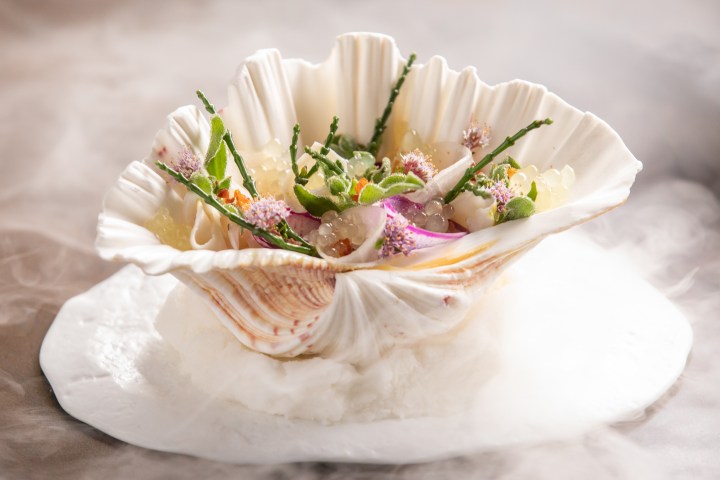
Chef Callan Austin conceptualised a dish called Ghost Net to create awareness of death nets at sea, which in turn led to being approached by MasterChef SA to showcase abalone in keeping with the show’s mandate to promote sustainability.
Aired on Tuesday, March 15, 2022, episode 10 of MasterChef SA season four began with 11 contestants still in the competition. By 7pm we had our top 10, who survived an exceptionally difficult challenge: prepare a fine dining abalone dish.
Abalone, or perlemoen, is like Marmite: You either love it or you hate it. If you hate it, chances are you haven’t had it properly prepared. Even if the cook swears their method is the best and only way to cook it, and it’s delicious so you’d better like it, it can be horrible. I speak from a specific experience here. I have tried, really I have. Once, many years ago, the late Bruce Robertson served it to me. At the time he was the chef at the Cape Grace and he had a tank of the live suckers in his office, off the kitchen. He was enthusiastic, as he always was about every ingredient, every dish, but sadly I was still not won over.
Even Callan Austin, who mere months earlier won the 2021 S Pellegrino award for social responsibility for his dish called Ghost Net when MasterChef SA tracked him down where he was working at Chefs Warehouse Tintswalo Atlantic to make a guest appearance on the show, had only worked with abalone once before, and not successfully either.
Austin was working at Le coin Français (Franschhoek) with Darren Badenhorst, whom he describes as his mentor, and together they had “played around” with abalone. At its price, it’s not something you can fiddle around with for too long while perfecting a recipe.
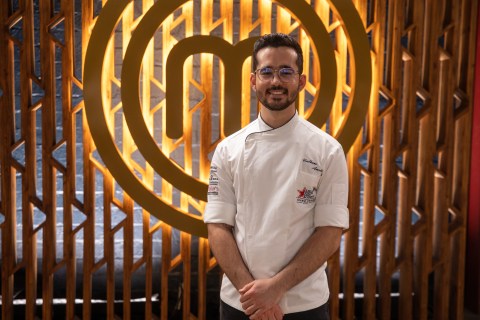
Chef Callan Austin on the set of MasterChef SA (Photo: Supplied)
For Austin, the brief to use abalone for MasterChef was an opportunity to shed light on the abalone farming industry and how it is sustainable, “because there is controversy around the ingredient,” he said.
“They sent me a few fresh abalone. I tried it raw and I tried it poached and I tried it over flame. Eventually I figured out what works and what doesn’t. I also realised, after you clean it, about 40 or 50% is deemed wastage, once you’ve trimmed off all the gristly bits. It’s so expensive and then to have to throw out half of it… So I minced and deep fried those offcuts, and as I agitated the bits in the fryer, it made these beautiful golden crispy nuggets.
“Then I made an XO, which traditionally uses scallops and prawns – neither of which are sustainable – and bougie ham. So again, I minced the abalone and it developed a crunchy yet chewy texture, which was interesting. I collected some seaweed which I blanched and refreshed, then chiffonaded and folded it through the XO. I got this glossy, chewy, sticky, sweet, seaweedy, umami sauce.”
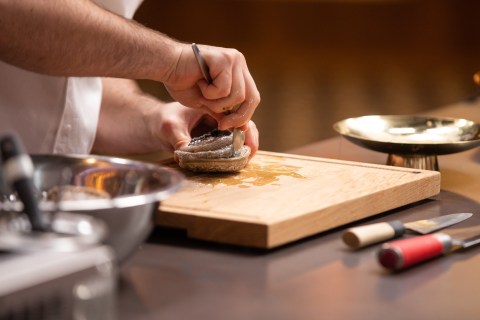
As much as 50% of an abalone can be wasted, unless a chef comes up with ways to use as much of it as possible. (Photo: Supplied)
Excellent, all the “waste” had been used. Austin then poached the flesh in a seaweed butter for about 20-25 minutes, and finished it on the hibachi with some teriyaki glaze for smokiness. In addition, the dish included raw ceviche with lime juice and zest, and salt. “I then built the dish with supporting seasonal elements – daikon from Meuse Farm in Hout Bay, gathered sea herbs – it was very ocean driven – and lime caviars,” said Austin. “It was tasty and looked cool served in a shell.”
The 11 contestants at the beginning of episode 10 got mini tasters of the dish for inspiration, and Austin also demonstrated how he makes it. It is a masterclass episode, the only one of the season. When he saw it in its full glory, Dr Harri (who follows me on Instagram, which is super cool and I was very glad he made it through to the next round) said the presentation was stunning and if it was put in front of him, he wouldn’t want to eat it. I find that so relatable. Often in fine dining restaurants I have to pause before destroying the art on the plate, and it’s not even to take pics for the ’gram. “Bring me another one to eat,” I quip hilariously.
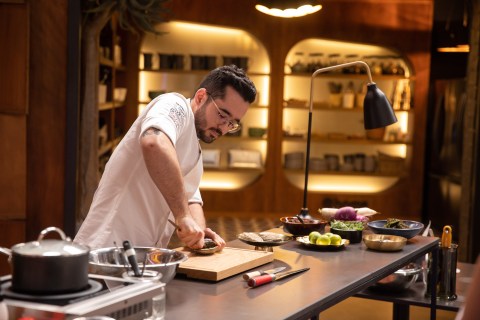
Rare, exquisite and very expensive… using abalone responsibly was the brief for MasterChef SA. (Photo: Supplied)
As you will have seen if you have already watched the episode, or will see if you’re saving it up to binge, the contestants had a bit of a tough time with the abalone but they did their best to honour it and treat it with respect. As if it’s not terrifying enough to be in the MasterChef kitchen with a ticking clock and roaming judges (shame, one contestant, Andriette, was shaking like a leaf as she tried to slice hers) without the cost of it hanging over your head too.
The wholesale price of premium abalone is R800 a kilogram (live weight on the shell, so one 500g “perlie” is R400), and R18,000 worth of it was used in the episode (from Abbagold, growers and suppliers of cultivated abalone) – but not a single scrap was wasted.
Besides fresh abalone, Abbagold also dries them for selected clients, usually one and two star Michelin restaurants in Hong Kong and Singapore. In this case, they go for between R1,000 and R2,000 a unit.
Let’s rewind a bit to the Ghost Net of which was spoken. “Do you know what a ghost net is?” Austin asked me; I confessed I did not. Neither does anyone else, he says. “It’s a trawling net that after a certain amount of time becomes too damaged so what they do is cut them loose and these float around the ocean.”
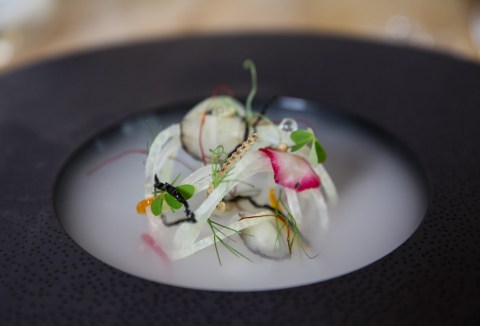
Ghost Net, a dish that is sustainable but represents something that is unsustainable. (Photo: Supplied)
These death nets take ages to biodegrade and a long time to sink, all the while entangling fish, sharks, and whales. When they eventually settle on the ocean bed and if it happens to be on a coral reef, it damages that too.
It was back in 2019 when Austin was working with Badenhorst, where he’d begun on the bottom rung of the kitchen hierarchy ladder and moved steadily up to become executive sous, that he wanted to enter a competition. Having previously competed himself, Badenhorst suggested the S Pellegrino Young Chef Academy. With only weeks until the deadline, Austin came up with the dish he calls Ghost Net. “It was very last minute, and I never expected to hear back,” he said. “The first version of the dish was very mediocre, but the concept pushed it over the line.”
Austin wanted to be useful as a chef and not just create tasty food. “Because chefs are like rock stars now – just look at MasterChef. I wanted to use that power of influence to educate people about a phenomenon they don’t know about.”
The dish is encased with spiralised kohlrabi, which makes the “netting” and covers several supporting elements beneath it, symbolising the creatures that get caught up in it. “The whole dish is sustainable but it represents something that is unsustainable,” explained Austin. Whether it was farmed or locally caught fish, every element had a special meaning. “I wanted to use octopus, but found out there’s no sustainable way to purchase it. It’s either by-catch, or they use the pot method tethered to buoys (which entangles whales) so no to that too.
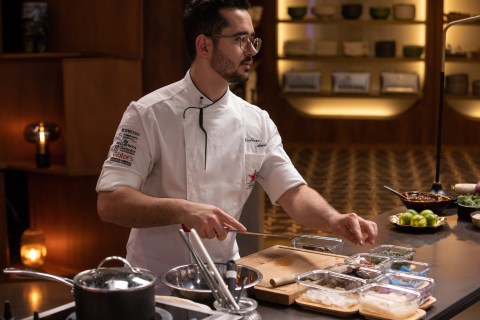
Callan Austin presented the only masterclass of this season of MasterChef SA. (Photo: Supplied)
“The moment something is too difficult, people turn to something else, but after weeks of research, I realised I’d have to catch it myself. I got a permit, and physically walked the shoreline with my little stick with a red ribbon and a hook, and caught them myself.
“For the ghost element, I collected seawater, heated it up for a salty aroma, and added dry ice for the smoke. Because of the shape of the bowl it’s served in, it settles in after pouring. It’s eerie, you can only see the top, and that’s the small number of people who actually know about it.”
Sustainability is close to Austin’s heart but he doesn’t want it to be his defining factor. “Regardless of who you are it’s important to be conscious of what has an impact on the environment. And everyone should do their part,” he said. “The name of the award is ‘social responsibility’ and for me that’s an umbrella term for a whole lot of things, not just sustainable ingredients and practices. I’d rather define myself as someone who drives a movement to create a better industry.”
Since filming the MasterChef episode, Austin has reunited with Badenhorst and with third partner Tom Pryor, they have a company called Storyboard Events. It was originally conceived during lockdown, went dormant, but has now been revived. It’s all about collaborations with chefs, venues, wine farms and distilleries to create spectacular events, like multi-course extravaganzas in the Two Oceans Aquarium, for example.
“We’re open to anything, anywhere, and have venues lined up in Joburg and Makers Landing, and the possibility of long-term pop ups,” said Austin. “I rock up at 9am, leave at 5pm and can go have dinner with my girlfriend, and see my parents. I have a life but I’m still doing what I love.” DM/TGIFood
Fans of MasterChef have the opportunity to meet the judges and eliminated contestants every Saturday and Sunday respectively, at Makers Landing. Tomorrow, March 19, 2022 at 11am Zola Nene will be doing her thing, followed by the contestants voted out this week, on Sunday, March 20. On Saturday, March 26, 2022 guest judge Bertus Basson will be there, and the final contestants voted out on Thursday, March 24, 2022 will make their appearance on Sunday, March 27, 2022.
MasterChef SA season 4 is on M-Net (DStv Channel 101), Mondays to Thursdays at 6pm. The finale will air on Thursday March 31. For more videos and news go to the official MasterChef South Africa page. Be part of the conversation #MasterChefSA and follow MasterChef South Africa on Twitter @MasterChef_SA, Instagram masterchef_sa or MasterChefSA’s Facebook page @MasterChefSA. Follow Callan Austin on Instagram @chef_callan_austin
Follow Bianca Coleman on Instagram @biancaleecoleman
The writer supports Ladles Of Love, which in six years, has grown from serving 70 meals at its first soup kitchen, to one of the most prolific food charity organisations in South Africa.




 Become an Insider
Become an Insider
Comments - Please login in order to comment.